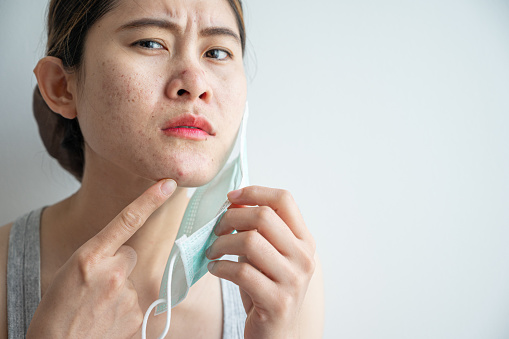Can be tested for Metabolic Disease
COVID-19, a coronavirus-related disease caused by severe acute respiratory syndrome coronavirus 2 sARS-CoV-2 (SARS-2), is not expected to abate soon. Skin Imprints the recent spike in cases due to new, potentially lethal variants, of the virus with immune evasion abilities, is threatening to overwhelm many healthcare systems across the globe, even though vaccines are being developed in many.
It is important to know how the illness can easily be diagnosed with more cost-effective and convenient methods. A new study has been posted to the preprint server at medRxiv*. It demonstrates the potential role skin imprints can play in testing for biomarkers that could indicate COVID-19 diagnosis.
Multiple abnormalities in SARS/CoV-2 infection
SARS-CoV-2 infection can cause multiple metabolic abnormalities that are triggered by a variety of immunological aberrations. These include and are mediated through coagulopathies, hyperintense inflammation processes, and others.
Infected cells can cause significant changes in protein and lipid metabolism, as many researchers have demonstrated in previous studies. These studies used mainly clinical specimens such as plasma, urine and saliva.
COVID-19’s symptoms reflect the distribution of the virus host receptor. Namely, the angiotensin-converting enzyme 2 (ACE2). These enzymes are found in the mouth, stomach, skin keratinocytes and gut. They are frequently involved in diseases.
COVID-19 is not a good place to get skin lesions. These may include reddish-violet, chilblain-like skin lesions on the fingers and toes, blisters and pepules as well as urticaria and purpuric spots. These could be due to the high levels of inflammation and coagulopathy that are common in this condition.This is why metabolites found on the skin could be an extremely useful resource for non-invasive and quick diagnosis of COVID-19.
Study Details
The current study was based on previous research that used silica plates to imprint skin, and mass spectrometry for analysis of the metabolite profile.
This would allow us to understand the metabolic signature change even in normal skin, and increase our knowledge about its pathophysiology.
All study participants were adults with COVID-19, diagnosed by reverse transcriptase-polymerase chain reaction (RT PCR), the gold standard for diagnosis after they reported symptoms of this illness. About 60% of those who were virus-positive were females, as opposed to the 80% of controls, who had similar symptoms, but tested negative. The participants’ skin imprints were taken on the upper left side.
What were the Results?
A broad metabolomic test showed that 14 markers had changed, with half showing an increase and half showing a decrease relative the controls.
The first category included primary fatty acids amides (PFAMs), glycerolipids, N-acylethanolamines and (NAEs) N-acyl amino acid. The following were reduced: phosphatidylserines (DIPs), dipeptides, and sterols.
The most notable changes were in oleamide and linoleamide. A diacylglycerol showed 87% higher values in COVID-19-patients.
The most significant amount of change was Skin Imprints observed in the controls dipeptide cysteinylglutamine, and phosphatidylserines.
Based on the receiver operating characteristics (ROC), oleamide modifications could predict infection with a accuracy of 77% and 77% specificity.
The panel of biomarkers showed a 74% sensitivity and an 82% specificity, which indicates the potential of the method.
What were the Skin Imprints Consequences?
These results highlight the importance of investigating COVID-19 manifestations that are not related to the respiratory, nervous, cardiovascular, hematologic, and gastrointestinal systems.
- Skin lipid alterations
These skin lesions are becoming more well-known. Despite the fact that keratinocytes express ACE2 receptors in higher levels than basal cells, this study employs a novel, noninvasive method to examine the metabolic alterations of the skin of COVID-19 patients.
COVID-19 has shown that the characteristics of sebum and triacylglycerol have been altered. In this study, too, both triglycerides as well as diacylglycerol were reduced.
Many viral infections are associated with disturbances in lipid metabolism. This is especially evident in COVID-19. Glycerolipid aberrations have been shown to correlate with both the severity and diagnosis of the disease.
- Important importance of phosphatidylserine modifications
In previous studies, the reduction of phosphatidylserines (COVID-19) in blood samples and upper-airway swabs was reported. Phosphatidylserine, a membrane phospholipid that has a negative charge and may be transferred from the inner layer to the outer layer during incipient viral infections, is reported in earlier studies.
It could signal macrophages that they should initiate phagocytosis. Additionally, it may trigger or enhance the cascade of inflammatory immunological modifications that is characteristic for severe COVID-19.
- Significance of fatty Acid Changes
Part of the PFAM group, fatty acids like oleamide or linoleamide seem to play a role in the regulation of both the nervous and immune systems. They also form part of the endocannabinoid systems and have the ability to regulate the activity of endocannabinoids through their receptors CB1 or CB2.
Increasing PFAM levels may cause endocannabinoids to be inactivated. This is because they, along with NAEs are inactive at cannabinoid receptors. This can increase the amount of active molecules and prolong their activity at receptors.
Future Skin Imprints Directions
CB2 can be found in skin and appendages as well as immune cells. These receptors have an immunosuppressive action and inhibit recruitment and activation for the first antiviral defenses. They reduce activation of T-helper cells and the inflammatory response. This effect may be used to treat COVID-19.
Researchers suggest that this method could be used to distinguish COVID-19 and other mild viral diseases. However, this risk stratification can only be achieved with more thorough studies and a larger number of patients.



